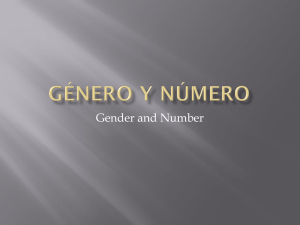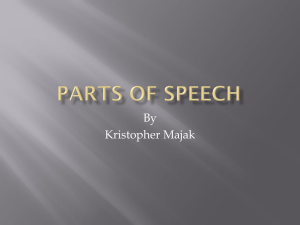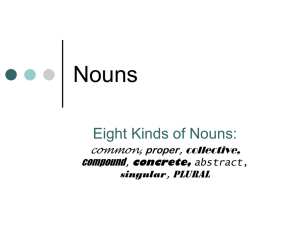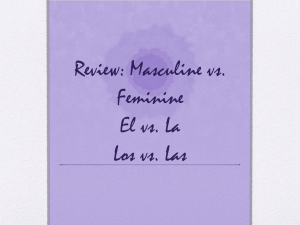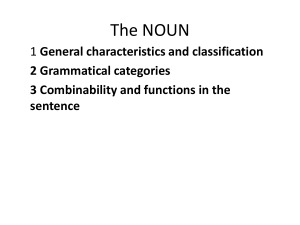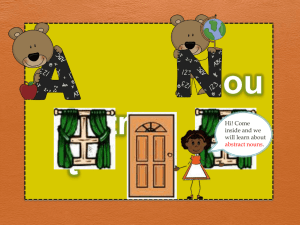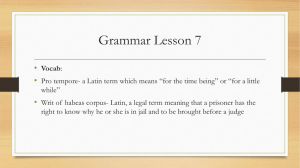noun
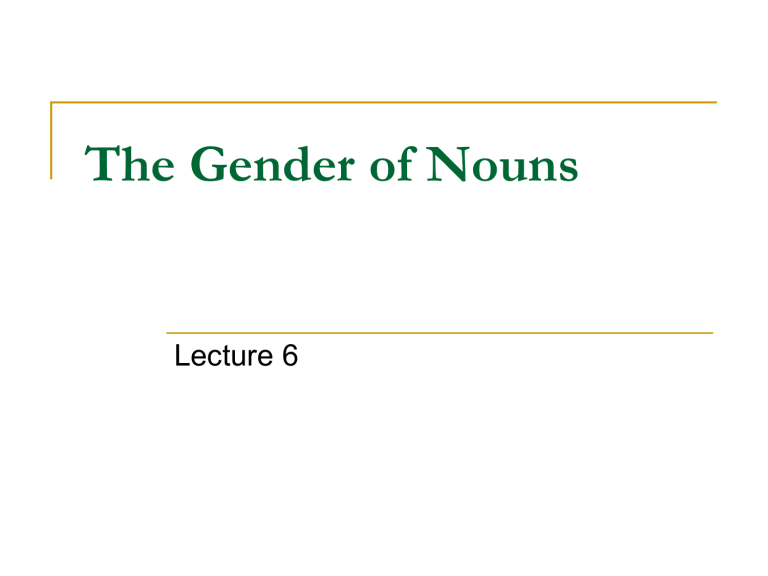
The Gender of Nouns
Lecture 6
Gender - a grammatical category of the
noun, which reflects the biological
category of sex of the noun referent.
It plays an important role in the grammar of some languages.
In Bulgarian a masculine noun + the masculine form of an adjective .
a noun in feminine + a different form of the same adjective feminine
In English gender distinctions are not formally marked in the noun or in the article.
According to their lexical semantics, nouns can be divided into neuter , masculine and feminine .
Neuter nouns denote lower animals , objects or abstract notions .
Neuter nouns can be substituted with the personal pronoun it and the relative pronoun which .
Masculine nouns denote human beings or
higher animals of male sex.
Masculine nouns can be substituted with the personal pronoun he and the relative pronoun who .
Feminine nouns denote human beings or higher animals of female sex .
Feminine nouns can be substituted with the personal pronoun she and the relative pronoun who .
How do we know when to use he, she or it?
We can classify names of human beings names of males & names of females.
In terms of structure there is nothing in the form of the proper noun to signal the sex of the referent.
Still it is possible to know from social experience whether it refers to males or females.
When such a name becomes the name of an inanimate object it still retains this feature in its semantic component no matter that it is not active, though another feature of the same nature /-sex / predominates.
+ proper
+ sex
+ animate
+ human
+ female
+ proper
-sex
animate
- human
+ female
The personal pronouns he, she, it and the relative pronouns who, which are gender-sensitive:
John is late ~ He is late
Mary is late ~ She is late
John and Mary are late ~ They are late
Here the choice of pronoun is determined by the sex of the person being referred to.
However, this distinction is lost in the plural
Sometimes the nouns in a pair are morphologically
marked for gender.
The marker is not considered to be a grammatical ending , but a derivational suffix : masculine feminine actor hunter lion hero widower usher actress huntress lioness heroine widow usherette
As for family names of humans the situation is different
A family consists of male and female members and that is why the family name as such has the semantic features /female/ and /+female/.
Depending on the referent one of them becomes active and the other passive.
The Johnsons
Mr Johnson +male
Mrs Johnson +female
In Bulgarian nouns are marked for gender
Bulgarian category of gender is very strong.
In маса , стол we have gender, but not sex.
маса +common
animate
- human
+ female
жена + common
+ animate
+ human
+ female
Gender differences are also manifested in
possessive pronouns (his/hers) and in reflexive
pronouns (himself/herself).
The natural distinctions reflected in such pairs as brother/sister, nephew/niece , and king/queen have no consequence for grammar.
While they refer to specific sexes, these words are not masculine or feminine in themselves.
These distinctions in spelling reflect differences in sex, but they have no grammatical implications.
For instance, we use the same form of an adjective whether we are referring to a waiter or to a waitress: an efficient waiter ~an efficient waitress
Here are some examples of nouns marked for GENDER
Masculine Feminine abbot abbess bachelor spinster, maid czar czarina duke
Francis duchess
Frances hero heroine monk nun tiger tigress
Masculine Feminine actor actress buck doe drake duck earl countess gander goose lion lioness ram ewe wizard witch
The category of gender can be said to be based on the functional oppositions of three categorical forms.
These oppositions can be presented in the following way: neuter masculine feminine
Gender Classes
Personal nouns [+human] and nouns denoting higher animals [- human; + animate] can be organized in pairs or groups according to their semantic relations.
Common countable nouns with the semantic feature
/+human/ fall into 2 groups as regards gender: nouns with one single semantic feature for sex, either /+male/ or /+female/ parent mother father child daughter son
Nouns with both semantic features for
sex in binary opposition +/-male
They cannot function simultaneously in one and the same linguistic context (usually denote an occupation or a status of the referent)
Common countable nouns with the semantic feature
/+animate/ but /-human/. Nouns with one single
semantic feature for sex, either /+male/ or /+female/ doe fawn stag buck mare filly stallion colt
Other nouns have two semantic features
for sex: /+male/ and /+female/
Sometimes the speaker employs combinations of words to make the information clear: boyfriend doctor noun + noun
– girlfriend
– lady doctor student – woman student buck-rabbit – doe-rabbit turkey-cock – turkey-hen frog – female frog adjective + noun nurse – male nurse personal pronoun + noun she-bear – he-bear name + noun billy-goat – nanny-goat
To the gender class of higher organisms belong nouns denoting:
a. names of countries countries are usually treated as inanimate nouns :
Belgium is a small country, but it is thickly populated.
If the country is referred to as a political , cultural or economic power , it can be substituted with the personal pronoun she :
Germany managed to stabilize her economy in a comparatively short period of time.
When the name of the country is used to refer to a sports team , it is treated as a collective improper noun and is substituted with they :
Italy can be proud of their success.
b. names of vessels, machinery or toys
they are usually treated as inanimate nouns :
We were watching a ship in the distance. It was rolling sluggishly from side to side.
some speakers substitute such nouns with personal pronouns referring to human beings . This is due to some personal involvement of the speaker with the noun referent:
Have you seen my sloop, which is in the dock? Isn’t she a beauty?
This phenomenon borders on personification .
Personification
showing particular qualities , emotions or the elements of Nature in the form of a person
When the qualities embodied are positive , the noun is treated as feminine :
Mary Ann has heard a lot about Nature. She is a kind of very powerful invisible fairly godmother, who is in charge of everything that happens in the world that’s not because of people or machines.
(A. Lurie)
When the qualities embodied are negative , the noun is treated as masculine : Death
Gender Bias in the Use of Gender Sensitive
Pronouns
The masculine pronouns he , him , his are not preferred nowadays to refer to an unspecified or hypothetical individual .
To avoid gender bias, English speakers tend to use the group of pronouns he or she when substituting nouns of common gender in formal speech:
Tell the next person who calls that he or she can make an appointment.
In spoken English they is used to refer back to an unspecified person:
What happens if someone changes their mind?
